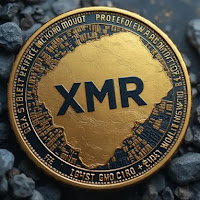Cryptocurrencies continue to make waves, and privacy coins like Monero are at the heart of it, caught between cutting-edge technology and the watchful gaze of regulators. Let’s dive into why Binance cutting ties with Monero is a big deal, and why holding onto an XMR wallet might still be a smart move.

Binance's Breakup with Monero
In a surprising move, Binance, one of the largest crypto exchanges globally, decided to delist Monero (XMR), along with Bitcoin Gold (BTG) and Bitshares (BTS). This removal isn’t an immediate exit but a gradual process that started with converting XMR holdings into USDC as of September 2, 2024. The conversion rate will be averaged from September 2024 to March 2025, with the funds available by the end of March.
This decision has raised eyebrows in the crypto community, especially among fans of privacy coins like Monero, which has gained a reputation for its untraceable transactions. Monero’s standout feature, ring signatures, ensures stealthy transfers, protecting users’ financial privacy from prying eyes.
| Event | Date | What’s Happening |
|---|---|---|
| XMR to USDC Conversion | Sept. 2, 2024 | Conversion rate averaged between Sept. 2024 and Mar. 2025 |
| Funds Available | Mar. 2025 | USDC funds unlocked |
Privacy Coins vs. Regulatory Scrutiny
Privacy coins like Monero, Zcash (ZEC), and Dash (DASH) offer users a cloak of anonymity in their financial transactions. But while these coins have a dedicated fanbase for the privacy they offer, governments view them with suspicion. Regulators fear that privacy coins are the go-to currency for illicit activities such as ransomware attacks and money laundering. As a result, some countries are considering outright bans or imposing stringent regulations.
Following Binance’s announcement, Monero’s price took a steep 35% dive, dropping to $100, signaling that its privacy-first approach might not align with the compliance standards of major exchanges like Binance.
| Coin | Regulators’ Concerns | Why Fans Love Them |
|---|---|---|
| Monero (XMR) | Bans, intense scrutiny | Shields financial privacy |
| Zcash (ZEC) | Potential misuse | Zero-knowledge proofs keep transactions confidential |
| Dash (DASH) | Legal obstacles | Fast, private transactions |
Despite regulatory challenges, privacy coins remain attractive to those who prioritize anonymity. However, the growing regulatory pressure means these coins must balance privacy with compliance if they are to survive in the mainstream crypto world.
Monero Price Analysis
Understanding Monero’s price movements involves looking at both current figures and broader trends.
Current Monero (XMR) Value
Monero’s current price is $149.38, down 0.2% from the previous day. Such minor fluctuations are common in the crypto market and typically don’t signify major concerns.
| Date | Monero (XMR) Value | Change |
|---|---|---|
| Yesterday | $149.68 | -0.2% |
| Now | $149.38 | -0.2% |
Monero Price Trends
Over the past couple of years, Monero’s price has bounced between two significant levels: a resistance level at $180 and a support level at $100. Since June 2022, Monero has made several attempts to break past the $180 resistance, but each time it has fallen back. Traders tend to sell when the price approaches $180, which halts any upward momentum. Meanwhile, the $100 support level acts as a safety net, preventing the price from dropping too far.
| Time Frame | High Point | Low Point |
|---|---|---|
| Past Two Years | $180 | $100 |
| Current Price | $149.38 | $100 |
Traders should keep a close watch as Monero hovers around $175. Whether it breaks past $180 or drops back toward $100 will be crucial in determining its next move. Recognizing patterns of reversals or breakouts can provide valuable insights into Monero’s future price trajectory.
Impact of Binance Delisting on Monero
Market Reaction
When Binance announced the delisting of Monero, the market reacted swiftly and sharply. Monero, known for its privacy-centric features like ring signatures, was no longer in line with Binance’s compliance standards. The result? A dramatic 35% price drop, with Monero plummeting to $100 by February.
| Event | XMR Price | Percentage Change |
|---|---|---|
| Before Delisting | $154 | - |
| After Delisting | $100 | -35% |
Monero wasn’t the only privacy coin affected—MobileCoin also experienced significant losses following Binance’s regulatory-driven decision.
Monero's Key Resistance and Support Levels
Monero has been consistently fluctuating between resistance at $180 and support at $100 for the past couple of years.
| Level | Price ($) | Description |
|---|---|---|
| Resistance | 180 | Point where traders start selling |
| Support | 100 | Provides a floor for price drops |
| Potential Resistance | 260 | Could emerge if $180 is surpassed |
Every time Monero approaches the $180 resistance level, a surge of sell orders keeps it from climbing higher. If Monero can eventually break past this level, the next key target would be $260, based on an $80 range stacked on top of $180 once cleared.
What’s Next for Monero?
Monero’s future remains uncertain, largely depending on the regulatory environment and market sentiment toward privacy coins. While Monero is still valued by those who prioritize financial privacy, its ongoing battle with regulators means it’s navigating uncharted territory. Stay tuned—the story of Monero is far from over.
Conclusion
The relationship between Monero and Binance is a snapshot of the wider tension between privacy coins and regulatory oversight. While Binance’s delisting of Monero signals a challenging road ahead for privacy coins, their core appeal—keeping financial transactions private—remains intact. Whether Monero and other privacy coins will be able to strike a balance between privacy and compliance will determine their future in the cryptocurrency market.

